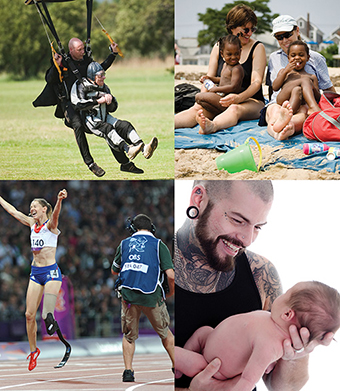Ascribed identity
Ascribed identities can be thought of as the identities that other people, or society, might impose on you. These include, for example, gender- and age-defined identities which are rooted in very early social experience.
There may be conflict between the two kinds of identity. Many social work service users, for example, find that their view of themselves (their self-identity) differs from society’s view of them (ascribed identity), and that frequently the latter is negative and based on a stereotype. Stereotyping is a process through which we assign a set of attributes to a person based on their presumed membership of a particular group. It also involves simplifying information about complex situations. For example, many older people find that their identity is seen only in terms of one attribute, their age, and the traits that are assumed to accompany that age, while their individual characteristics, capabilities and experiences are ignored. Similarly, people with mental health problems are often portrayed as one group and are frequently stereotyped in films, books and television as being stupid or violent and therefore to be feared.
Stereotypes represent society’s views in a rigid and simplistic way. It can be all too easy for individuals to absorb or internalise stereotypes so that they come to believe they are true of themselves or of others. It is an important part of social work to become aware of how we may have internalised some assumptions about people before getting to know the real person. You may feel you have been stereotyped yourself. For example, you might have come across some stereotypes of social workers and noticed that this affects your views of social work.
- How accurate do you think these stereotypes are?
- Do they contain any truths?
- How does it make you feel to be stereotyped in that way?
While we recognise that stereotypes exist in our culture and can become part of our personal responses and attitudes, it is important in social work that we spend time thinking about, and becoming aware of, our assumptions.
Activity 6 Thinking about your own stereotypes
Look at these images and answer the questions below.

Consider the following questions:
- Have a guess at who and what are the four pictures depicting.
- In what ways do you think some people or groups might be stereotyped by society at large?
- Do you think representations of these people or groups reinforce the stereotypes or challenge them?
- Are there any stereotypes of people or groups that you think you might have held in the past or are affected by now?
Make a note of any time you think you have been stereotyped. How did this feel?
Discussion
Based on a single image it can be hard to establish who and what the pictures are about with complete certainty. But it’s likely we will ‘read’ certain aspects of the pictures in similar ways. For example, the first image appears to be an older adult about to land after a tandem sky dive. The second picture depicts what seems to be two women and two children having fun on a beach. But what assumptions do you first make about the relationships between the people in the picture? For instance, are the women a couple? And are they the parents of the two children? The third image appears to be an elite athlete, possibly a Team GB Paralympian, celebrating. The last picture is a man with numerous tattoos (a form of body modification often associated with ‘tough guy’ personas) looking lovingly at the baby he is carefully holding.
These images have been chosen because they challenge selected stereotypes – for instance, the assumption that older people do not take part in dangerous, adrenaline-filled activities. The pictures were chosen to suggest that stereotypes should be challenged and thought about. How did you react to them? Did you react differently depending on the picture and perhaps some of the assumptions you made? Do you have other examples of stereotypes you would like to challenge?
It is not easy to challenge certain stereotypes, but it is important to do so. We can all be influenced by what other people think, but part of building good social work skills is to reflect on the assumptions we make about how people might think, feel or behave on the basis of a stereotype.
